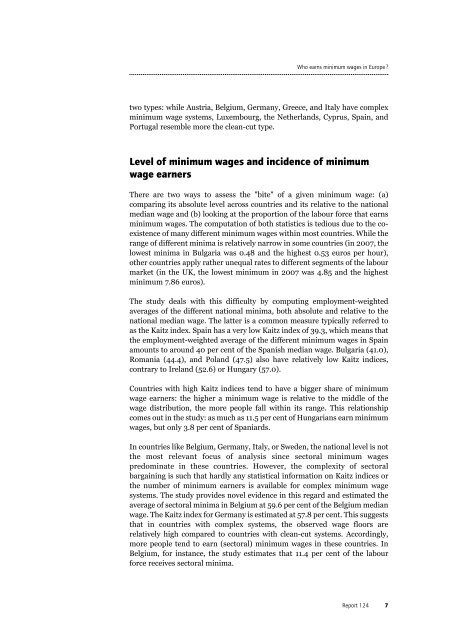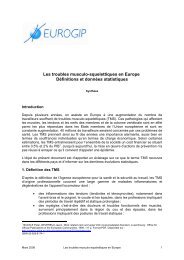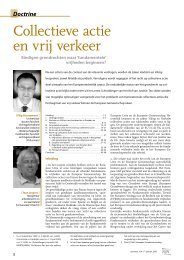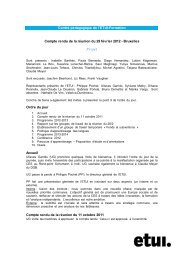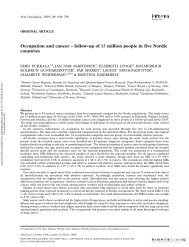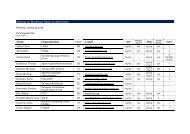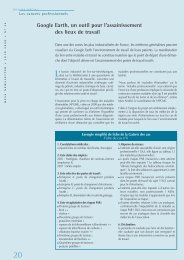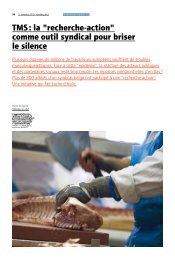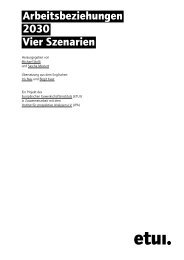Who earns minimum wages in Europe - European Trade Union ...
Who earns minimum wages in Europe - European Trade Union ...
Who earns minimum wages in Europe - European Trade Union ...
You also want an ePaper? Increase the reach of your titles
YUMPU automatically turns print PDFs into web optimized ePapers that Google loves.
<strong>Who</strong> <strong>earns</strong> <strong>m<strong>in</strong>imum</strong> <strong>wages</strong> <strong>in</strong> <strong>Europe</strong> ?<br />
two types: while Austria, Belgium, Germany, Greece, and Italy have complex<br />
<strong>m<strong>in</strong>imum</strong> wage systems, Luxembourg, the Netherlands, Cyprus, Spa<strong>in</strong>, and<br />
Portugal resemble more the clean-cut type.<br />
Level of <strong>m<strong>in</strong>imum</strong> <strong>wages</strong> and <strong>in</strong>cidence of <strong>m<strong>in</strong>imum</strong><br />
wage earners<br />
There are two ways to assess the "bite" of a given <strong>m<strong>in</strong>imum</strong> wage: (a)<br />
compar<strong>in</strong>g its absolute level across countries and its relative to the national<br />
median wage and (b) look<strong>in</strong>g at the proportion of the labour force that <strong>earns</strong><br />
<strong>m<strong>in</strong>imum</strong> <strong>wages</strong>. The computation of both statistics is tedious due to the coexistence<br />
of many different <strong>m<strong>in</strong>imum</strong> <strong>wages</strong> with<strong>in</strong> most countries. While the<br />
range of different m<strong>in</strong>ima is relatively narrow <strong>in</strong> some countries (<strong>in</strong> 2007, the<br />
lowest m<strong>in</strong>ima <strong>in</strong> Bulgaria was 0.48 and the highest 0.53 euros per hour),<br />
other countries apply rather unequal rates to different segments of the labour<br />
market (<strong>in</strong> the UK, the lowest <strong>m<strong>in</strong>imum</strong> <strong>in</strong> 2007 was 4.85 and the highest<br />
<strong>m<strong>in</strong>imum</strong> 7.86 euros).<br />
The study deals with this difficulty by comput<strong>in</strong>g employment-weighted<br />
averages of the different national m<strong>in</strong>ima, both absolute and relative to the<br />
national median wage. The latter is a common measure typically referred to<br />
as the Kaitz <strong>in</strong>dex. Spa<strong>in</strong> has a very low Kaitz <strong>in</strong>dex of 39.3, which means that<br />
the employment-weighted average of the different <strong>m<strong>in</strong>imum</strong> <strong>wages</strong> <strong>in</strong> Spa<strong>in</strong><br />
amounts to around 40 per cent of the Spanish median wage. Bulgaria (41.0),<br />
Romania (44.4), and Poland (47.5) also have relatively low Kaitz <strong>in</strong>dices,<br />
contrary to Ireland (52.6) or Hungary (57.0).<br />
Countries with high Kaitz <strong>in</strong>dices tend to have a bigger share of <strong>m<strong>in</strong>imum</strong><br />
wage earners: the higher a <strong>m<strong>in</strong>imum</strong> wage is relative to the middle of the<br />
wage distribution, the more people fall with<strong>in</strong> its range. This relationship<br />
comes out <strong>in</strong> the study: as much as 11.5 per cent of Hungarians earn <strong>m<strong>in</strong>imum</strong><br />
<strong>wages</strong>, but only 3.8 per cent of Spaniards.<br />
In countries like Belgium, Germany, Italy, or Sweden, the national level is not<br />
the most relevant focus of analysis s<strong>in</strong>ce sectoral <strong>m<strong>in</strong>imum</strong> <strong>wages</strong><br />
predom<strong>in</strong>ate <strong>in</strong> these countries. However, the complexity of sectoral<br />
barga<strong>in</strong><strong>in</strong>g is such that hardly any statistical <strong>in</strong>formation on Kaitz <strong>in</strong>dices or<br />
the number of <strong>m<strong>in</strong>imum</strong> earners is available for complex <strong>m<strong>in</strong>imum</strong> wage<br />
systems. The study provides novel evidence <strong>in</strong> this regard and estimated the<br />
average of sectoral m<strong>in</strong>ima <strong>in</strong> Belgium at 59.6 per cent of the Belgium median<br />
wage. The Kaitz <strong>in</strong>dex for Germany is estimated at 57.8 per cent. This suggests<br />
that <strong>in</strong> countries with complex systems, the observed wage floors are<br />
relatively high compared to countries with clean-cut systems. Accord<strong>in</strong>gly,<br />
more people tend to earn (sectoral) <strong>m<strong>in</strong>imum</strong> <strong>wages</strong> <strong>in</strong> these countries. In<br />
Belgium, for <strong>in</strong>stance, the study estimates that 11.4 per cent of the labour<br />
force receives sectoral m<strong>in</strong>ima.<br />
Report 124<br />
7


